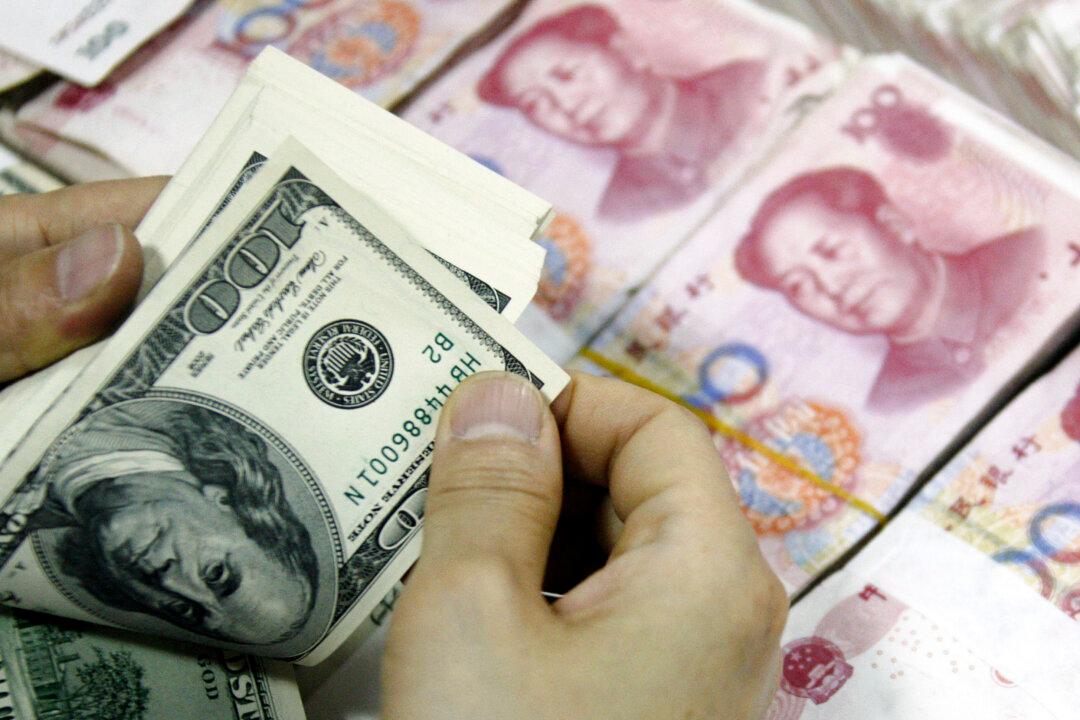Beijing has allowed the Chinese yuan, or renminbi (RMB), exchange rate to weaken, with the offshore yuan falling to 7.4290 per U.S. dollar amid escalating U.S.–China trade tensions.
On April 8, the People’s Bank of China (PBOC) set the yuan’s central parity rate at 7.2038, marking the first time since September 2023 that the rate has surpassed the 7.20 threshold.
The depreciation of the yuan is widely seen as a countermeasure by Beijing to offset the impact of the new U.S. tariff hikes. During U.S. President Donald Trump’s first term, Beijing allowed the yuan to depreciate by more than 10 percent against the dollar in response to tariffs.
On April 4, the Chinese communist regime announced that starting from April 10, it would impose a 34 percent tariff on all imports from the United States, and 16 U.S. entities would be placed on an export control list. This would prevent six U.S. companies from engaging in import and export activities related to China, and export controls would also be imposed on seven types of rare earth-related products.
White House Press Secretary Karoline Leavitt said on April 8 that nearly 70 countries had reached out to Trump to initiate trade negotiations.
Southeast Asian countries like Indonesia, Cambodia, and Vietnam—one of the main regions from where made-in-China products are rerouted to the United States—have all expressed their desire to find a solution with Washington to restructure their trade in a way that doesn’t favor communist China.
Beijing is the only one in the region resorting to retaliation.
On April 7, the three major A-share indexes in China experienced significant declines. The Hong Kong stock market saw a significant decline, with the Hang Seng Index plunging by 3,021 points, or 13.22 percent, closing at 19,828 points, marking its largest single-day points loss since 1997.
The sharp falls in the Chinese and Hong Kong stock markets at the opening were seen as a direct reaction to the escalation of the U.S.-China trade conflict.
Experts on Chinese Yuan Depreciation
Some analysts and economists stated that while a weaker yuan could make the tariffs on exports more affordable and help ease pressure on China’s export-reliant economy, a sharp decline might trigger undesirable capital outflows and pose a risk to the nation’s financial stability.
“Beijing’s more strident stance on U.S. tariffs could align with some softening in the yuan to better absorb incoming shocks,” said Vishnu Varathan, head of macro research for Asia excluding Japan at Mizuho Bank. “But the People’s Bank of China will not desire or pursue sharp depreciation as financial stability features.”
According to a recent analysis by Barclays strategists Sheryl Dong and Themistoklis Fiotakis, the yuan could depreciate by as much as 21 percent in the most extreme scenario, which means that the USD-yuan exchange rate would continue to increase to 9.8 or even reach close to 10.
David Huang, a U.S.-based economist, said that a 21 percent depreciation of the yuan is unlikely to occur, as unless a war breaks out in the Taiwan Strait, the possibility of such extreme depreciation is very low. Barclays may be attempting through its reports to guide its clients to divest from yuan assets and positions.
The pricing of the yuan exchange rate is subject to significant administrative intervention, making it difficult to accurately forecast through market-driven mechanisms, Huang previously told The Epoch Times.

In the context of the decoupling of U.S.-China trade and technology, if the yuan continues to depreciate, China could be labeled a currency manipulator by the United States, potentially facing a new round of punitive tariffs or other sanctions, he said.
The term “currency manipulator” originates from the U.S. Treasury Department, which uses three criteria to make its determination: 1. The economy has a trade surplus with the United States of over $20 billion; 2. the economy’s current account surplus accounts for at least 3 percent of its GDP; 3. the economy consistently intervenes in the foreign exchange market to push its currency in a specific direction.
If a country meets these criteria and the Treasury Department labels it a currency manipulator, the White House may initiate negotiations or possibly take retaliatory measures.
During Trump’s first term, in early August 2019, shortly after the USD-yuan exchange rate fell below 7, then Treasury Secretary Steven Mnuchin declared that China was manipulating its currency—the first time that had happened in 25 years.
What Would Happen If Yuan Falls Below 8?
The yuan-to-dollar exchange rate has long been influenced by the psychological barrier of “maintaining 7.”
During the 2008 financial crisis, the yuan appreciated significantly, with the USD-yuan exchange rate falling from 7.8 to 6.8. To maintain exchange rate stability, the PBOC adopted a strategy of pegging the yuan to the USD, keeping the exchange rate within the 6.8 to 6.89 range.
In 2016, the yuan faced downward pressure, and the USD-yuan central parity rate briefly rose to 6.96. To prevent the exchange rate from breaking through the threshold of 7, the PBOC intervened heavily in the foreign exchange market.
After that, the market generally followed the strategy of “maintaining 7.”
Huang estimated that if the USD-yuan exchange rate were to break through 8, it could trigger a global crisis of confidence among investors regarding the Chinese Communist Party’s (CCP’s) ability to manage China’s finances.
If the yuan were to depreciate significantly, it would trigger mass capital outflows from China, and with domestic funds already heavily invested in gold and other safe-haven assets, intensifying capital flight could push the Chinese economy to the brink of collapse, he said.
Additionally, import costs would rise sharply. Aside from daily necessities, microchips, and oil, China is also heavily reliant on food imports, and the CCP would need to use substantial amounts of U.S. dollars to procure these critical goods.
Jessica Mao, Xiaohua Gu, and Reuters contributed to this report.




